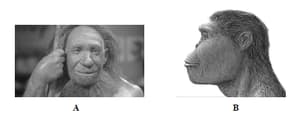What is the scientific name of Neanderthal man?
Important Questions on Communicate scientific information that common ancestry and biological evolution are supported by multiple lines of empirical evidence.
Statement (S): Less than of the human genome encodes for functional units called 'proteins'.
Reason (R): The majority of the human genome is regulatory in nature.
Which of the following is true?
Statement I: Organs which have similar structure and origin but perform different functions are called analogous organs.
Statement II : The sudden appearance of some vestigial organs in a better developed condition is called atavism
The correct option among the following is
Given below are two stages in the evolution of man.
Study them and answer the questions that follow:

(i) Identify Australopithecus and Neanderthal man from the above pictures.
(ii) Mention two characteristic features each for the two stages.
(iii) Who proposed the theory of ‘Natural Selection'?
(iv) Name the organism used as an example to explain ‘Industrial Melanism’.
(v) Give two examples of Vestigial organs in humans.
Study the following statements
I) Gene that codes for the synthesis of dystrophin is the largest human gene
II) Chromosome contains the highest number of genes
III Endonucleases are used to cut the DNA at specific region
IV) Whole hereditary information encoded in DNA of an organism is called genome
Among the above identify the correct statements
Write the names of the following:
A 2 mya primate that lived in East African grasslands.
Match the following
| Set-I | Set-II | ||
| (A) | Cyanognathus | (I) | Reptiles & birds |
| (B) | Archaeopteryx | (II) | Amphibians & reptiles |
| (C) | Seymouria | (III) | Reptiles & mammals |
| (D) | Eusthenopteron | (IV) | Protochordates & fishes |
| (V) | Fishes & amphibians |
The correct match is
Match List with List.
| List | List | ||
| (a) | Adaptive radiation | (i) | Selection of resistant varieties due to excessive use of herbicides and pesticides |
| (b) | Convergent evolution | (ii) | Bones of forelimbs in Man and Whale |
| (c) | Divergent evolution | (iii) | Wings of Butterfly and Bird |
| (d) | Evolution by anthropogenic action | (iv) | Darwin Finches |
Write the names of the following :
A 15 mya primate that was ape-like.

